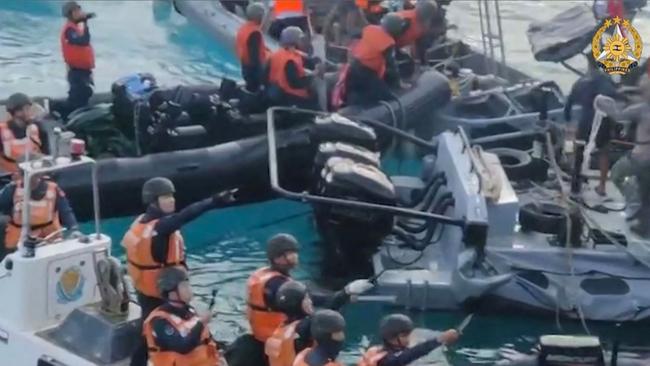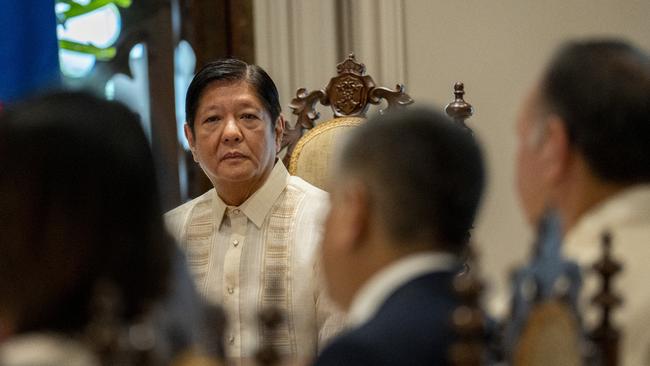Philippines adds Singapore to its ‘security web’ against China
Manila’s new defence pacts have incensed Beijing but further raised the cost for China of open conflict in the South China Sea.

The Philippines has signed a new defence security agreement with Singapore, a fortnight after finalising a landmark pact with Japan, in twin moves that have incensed Beijing but further raised the cost for China of open conflict in the South China Sea.
While few details have emerged about the Singapore pact signed on Wednesday, beyond broadening military-to-military engagement, the deal adds heft to Manila’s strategy of building a defensive web of partners and allies as it contends with growing Chinese hostility in its maritime waters.
On Monday, Philippines Defence Secretary Gilberto Teodoro said he hoped to also finalise reciprocal troop access arrangements this year with Canada, France and New Zealand – all of which have expressed support for Manila’s claims within its exclusive economic zone.
Those would be similar to Manila’s defence pact with Tokyo which allows the deployment of forces on each other’s soil in the face of Beijing’s aggressive claims to the South China Sea, which were rejected in 2016 by a UN Permanent Court of Arbitration.
“The Philippines is trying to tie itself into a web of partners and allies so that when China looks at them they don’t see just The Philippines,” Ray Powell, from Stanford University’s Gordion Knot Centre for Maritime Security Innovation, said on Thursday.
“They already see The Philippines and the US but Manila is now trying to broaden that scope to give them more options and capability. It’s not just about having more friends to deter China but to help The Philippines build their capacity, which is a long-term proposition but has to start somewhere.”

Tokyo has agreed to help Manila acquire more coastal ships and radar capability, while Canada has offered to provide dark vessel detection technology.
The Marcos administration has been building defence alliances with Asian and Western powers, including Australia, for more than 18 months to help shore up its security position.
Controversially, it has also expanded to nine the number of military bases accessible to its defence treaty partner, the US.
Beijing has accused the US and The Philippines of endangering regional security through those actions, which Manila has angrily denied.
In his state of the nation address on Monday, President Ferdinand Marcos Jr said Manila would not back down in its territorial disputes.
“In the face of challenges to our territorial sovereignty, we will assert our rights and interests in the same fair and pacific way we have always done,” he said, adding his administration would continue its efforts “to strengthen our defence posture, through developing self-reliance and partnerships with like-minded states”.
So successful has The Philippines been in leveraging its asymmetric conflict with China to coalesce Western powers around its cause, it has become “almost a selling point for Western nations that want to be a player in the Indo-Pacific”, Mr Powell said.
“If you’re a Western power and you have the choice to give aid to The Philippines or Malaysia, the Philippines has a better argument.”
The risk for Mr Marcos, however, was that he “won’t be able to staunch the bleed in the West Philippines Sea where they are stuck on this second Thomas Shoal issue”.
Escalating hostilities between Beijing and Manila culminated in June in a confrontation in which armed Chinese coastguard surrounded and attacked a Philippines vessel as it sought to resupply the Sierra Madre, a navy ship grounded as a military outpost on the Second Thomas Shoal which China also claims.
The clash, in which a Philippines’ sailor lost his finger, came days after Mr Marcos warned that the wilful killing of a Filipino serviceman or citizen in the West Philippine Sea would “come very close to an act of war”.
Last week, The Philippines’ foreign ministry claimed it had reached agreement with China enabling the resupply of the Sierra Madre, free of any concessions to previous demands that it receive advance notice of all resupply missions and inspect any resupply vessels. Beijing quickly denied a deal had been struck.
Mr Powell said while Manila’s new “transparency tactic” of publicising all maritime confrontations with China had raised the reputational cost for Beijing of the ongoing conflict, the fact both sides’ positions were hardening was a concern.




To join the conversation, please log in. Don't have an account? Register
Join the conversation, you are commenting as Logout